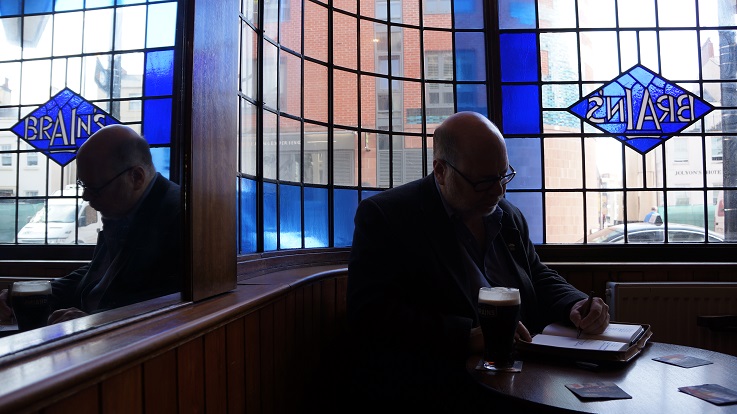 |
96. Apperception
Approaching the museum in Cathays Park here in Cardiff, in times previous and times to come, one would be confronted by a Greek temple, a style advocated by many museums and resembling a mausoleum in appearance. Who is to say it doesn’t also resemble a mausoleum in purpose, a tribute to the dead and their achievements? Since summer, most of the museum has disappeared behind scaffolding and tenting. The roof is being repaired. The previous repair had been incorrectly done. Important drains had been covered causing leaks. They are also replacing antiquated electricals and installing air conditioning essential for conservation.
A sliver of the façade remains in view, the front entrance. Carved into the stone above the Doric columns are the Welsh words, “AMGUEDDFA GENEDLAETHOL CYMRU”, which translate to “National Museum Wales”. The name has come to include a network of museums. This grand edifice, temporarily wrapped, as if by the artist Christo, is commonly known as the National Museum [of] Cardiff.
Recently, the National Museum Cardiff has an unusual visitor. The first thing you confront when you enter the Main Hall is the colossal Dippy the Diplodocus. He is on tour from the Natural History Museum London and is visiting for several months. He will be loping off before the end of January. This long neck, long tailed dinosaur skeleton stretches 70 feet, nearly half way across the main hall. I watched local children gawk in wonder and recalled my first confrontation with dinosaur skeletons. I was visiting the American Museum of Natural History in Manhattan. I was five years old. That experience changed me. Would it similarly affect these children? It seeded a lifelong interest that gave me an advantage in understanding the magnitude of time and the marvel of evolution.
I noted how Dippy had been mounted on its frame to appear lifelike. The frame could not have held aloft heavy fossils. This was merely a plaster copy of the original fossils dug out of the earth in Wyoming and exhibited at Pittsburgh’s Carnegie Museum of Natural History. I took pride in recognizing this was not the real thing, merely a similitude. Then I thought how silly of me to think even fossils are original. They are similitudes of flesh and bone that geological time has replaced with minerals.
In my lifetime, we have learned a staggering amount from dinosaur remains, information that was not thought discoverable when I was a child. When I was a child, the Brontosaurus was a giant, cold-blooded lizard that dragged its tail according to the popular paintings of Charles R. Knight. They buoyed their weight in shallow waters because they were so heavy. When I was a child, pterodactyls could not fly, had to climb steep cliffs before launching themselves into a glide. But they did fly! And dinosaurs were warm-blooded, had feathers, were indeed birds. It was thought we would never know their colors, but now we know some. We thought they might have died out because the earth became too cold, but we now know the mass extinction was because an asteroid collided with earth 65 million years ago - and they never did die out. I see them in the movements of geese and ostriches. All this comes to mind when I peer at Dippy and much more. (We now know Bob, a 68-million-year old T. rex was actually female and pregnant. We know this because Mary Higby Schweitzer and her lab technician, Jennifer Wittmeyer, discovered bone, soft tissue, and blood cells preserved inside the rock fossil of Bob’s leg bone.)
Natural history is only a part of this wonderful museum. The National Museum Cardiff also contains a wonderful collection of paintings and sculptures, and a large collection of Welsh ceramic art. Examples appear in vitrines along the mezzanine, but the collection is concentrated in the Welsh Ceramics Gallery.
In her last year of life, Ms Keogh, my cherished companion, tired quickly. As I proceeded through the exhibitions, she would retire to the Welsh Ceramics Gallery, a room in the southeast corner of the building. It was not frequented by the museum-goers. Having a glass dome and skylights, it became very warm. Ms Keogh would stretch out on a bench in the gallery and nap until I came to collect her. When I visit the museum now, I make a point of entering the gallery, hoping to see her alive again and to collect her.
What we see when we look at art and artifact are associations crafted and gathered through a lifetime of experiences. The museum is a mere fifteen minute stroll from my flat and I belong to Friends of National Museum Wales, a life member.
![]()
Mr Bentzman will continue to report here regularly about
the events and concerns of his life. If you've any
comments or suggestions, he would be pleased to hear from you.
You can find his
several books at www.Bentzman.com.
Enshrined
Inside Me, his second collection of
essays, is now available to purchase.
